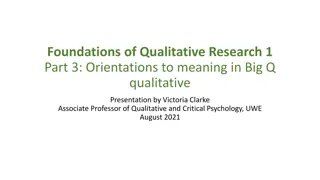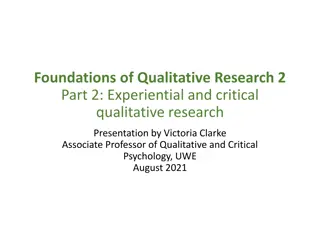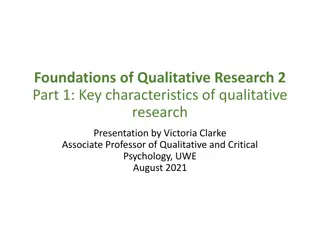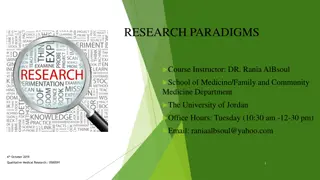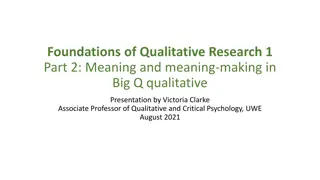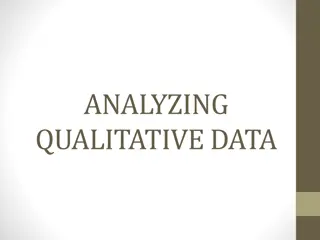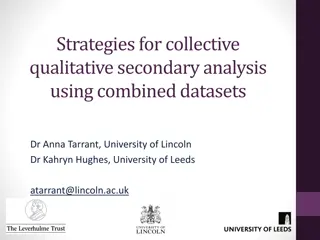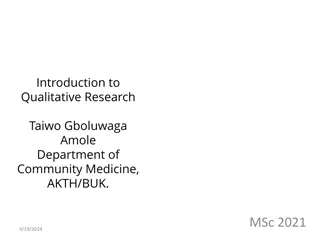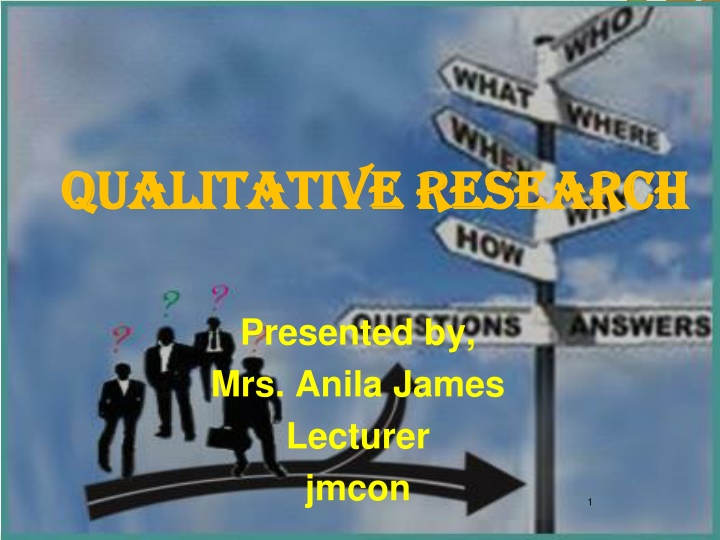
Qualitative Research in Depth
Dive into the world of qualitative research with Mrs. Anila James to grasp the essence of research design, types, and researcher qualities. Explore the basics, types, and examples of qualitative research to enhance your understanding.
Download Presentation

Please find below an Image/Link to download the presentation.
The content on the website is provided AS IS for your information and personal use only. It may not be sold, licensed, or shared on other websites without obtaining consent from the author. If you encounter any issues during the download, it is possible that the publisher has removed the file from their server.
You are allowed to download the files provided on this website for personal or commercial use, subject to the condition that they are used lawfully. All files are the property of their respective owners.
The content on the website is provided AS IS for your information and personal use only. It may not be sold, licensed, or shared on other websites without obtaining consent from the author.
E N D
Presentation Transcript
QUALITATIVE RESEARCH QUALITATIVE RESEARCH Presented by, Mrs. Anila James Lecturer jmcon 1
CENTRAL OBJECTIVES At the end of teaching students acquire depth knowledge on qualitative research design and able to explain and apply this knowledge in the research studies.
SPECIFIC OBJECTIVES At the end of the class student will be able to Define qualitative research design Explain the types of qualitative research design Describe the advantages and disadvantages of qualitative research design
What is Qualitative Research? It represents a basic level of enquiry (Naturalistic ) that seeks to discover and understand concepts, phenomena or cultures.
RESEARCHER QUALITIES An open and enquiring mind. components; Appreciating context; Good listening Capturing mood and affective Sensitivity. Adaptiveness & Flexibility. Grasp of the issues to interpret information. Lack of bias with openness to contrary findings. 5
Types of qualitative research Phenomenology Ethnographic study Grounded theory Case study Historical research 6
Phenomenology: Phenomenological study is a science whose purpose is to describe particular phenomena or the appearance of things as lived experience (Cohen, 1987). 7
Example The lived experience of a mother who lost her children during the Tsunami. 8
Data generation: formal and informal interviews participant observation field notes memoing observation and participation in family activities audio taped interviews Triangulation Interim summary Formal interviews audio taped and transcribed verbatim by professional transcriptionist
Contd.. Data presented to families for validation and more input Redundancy (data saturation) provided criterion for ending data collection. Audit trail-having a full record of all activities (field notes, researcher diary, raw data, coding and analytical process) Debriefing- peers Above were imported into a computer software programme for data management and analysis Coded data clustered into broad categories and further into meaningful themes
ETHNOGRAPHY- Portrait of people Derived from anthropology The work of describing culture. Provides a mechanism for studying our own culture and that of others. 12
Steps of ethnographic research Identify the culture to be studied Identify the significant variables with in the culture Literature review Gaining entry Cultural immersion Acquiring informants Gathering data Analysis of data Description of culture Theory development 13
Fundamental characteristics of ethnography Researcher is the instrument Fieldwork. The cyclic nature of data collection and analysis. The focus is on culture. Cultural immersion. Reflexivity.
Example. Exploration of the understanding and meaning of chronically ill adults about their body image. 15
Grounded Theory . Studies in which data are collected and analyzed and then a theory is developed that is grounded in the data. 16
Example To describe the experience of patients who were on ventilators & the impact of it on their quality of life. Thematic analysis was used to describe quality of life.
Case study method An intensive investigation of single situations which serve to identify and describe basic phenomena. Case studies provide an excellent opportunity for triangulation: that is, using a number of research methods to complement and confirm findings. Using observation (participant/non participant), interviews and questionnaire 18
Historical approach A narrative description or analysis of events that occurred in the remote or recent past. Example .. What causes war? Researcher develop the explanation of the causes of war 19
CONCEPT OF HISTORICAL RESEARCH Past oriented, may be longitudinal or cross sectional in nature. Historical research may be more difficult to conduct than some of the other types of research. Concerns identification, location, evaluation and synthesis of data from the past. Discovers past events to relate present and to the future. Uses all the steps of the scientific method. Has no scope to produce or alter the form of data but to find data and accept the data .
STEPS OF HISTORICAL RESEARCH Defining a problem area. Developing specific Questions/Hypothesis. Collection of Data. Analysis of Data. Interpretation Researcher should devote considerable efforts to identifying and evaluating data sources on events, situations and human behavior that occurred in the past.
COLLECTION OF DATA Collection of data may require months or years of dedicated searching from periodicals, newspapers, magazines, diaries, letters, books, minutes of meetings, medical or legal documents. Non written materials like relics and artifacts. Visual materials in form of photographs and films. Audio Materials like tapes and records. Oral reports in form of Interviews.
DATA ANALYSIS AND INTERPRETATION Researcher must not only be aware of their own bias and that of ideology but also bias from data sources. Researcher explains not only what happened but how and why it happened. Explores relationships among events, ideas, people, organizations and institutions and interpret them within the context of the period being studied. Researcher be sensitive to material , must show genuine engagement in the subject, balance the forces of self interest, societal interest and historical interest to achieve a coherent , convincing and meaningful account.
RESEARCH PROCESS IN A QUALITATIVE DESIGN Statement of the problem lived experience of mothers of extreme preterm neonates admitted in NICU, selected Hospital 24
Purpose To discover, to describe, to understand 25
Review of literature Researcher reviews the literature to compare the findings of qualitative research after data analysis. 26
Research Methodology Research Design Emergent nature of design Methodological triangulation Researcher is part of research process Subjective 27
Setting Naturalistic setting Place where individuals of interest live 28
Population Mothers whose babies were admitted in St John Medical College Hospital. 29
Sample Participants must have experienced the phenomena Subjects Terms such as participants or informants are used. 30
Sample size No criteria for sample size Depends upon the purpose and the quality of informants Guiding principle is data saturation Sampling to a point that no new information is achieved Number needed for saturation depends on data quality and type of data. 31
Types of data Self report Usually large amount of text Observation Physiologic data Decisions about what to collect evolve in the field 32
Tool for data collection Researcher as instrument Researcher interprets data 33
Tool for data collection Researcher as instrument Researcher interprets data 34
Data Collection Procedure Interview, observation, field notes, participant interaction and other type of physical evidences. 35
Data Analysis Narrative analysis Data triangulation 36
Steps in qualitative data analysis Reading: Developing an intimate relationship with the data Coding: Identifying emergent themes Choosing & using a computer software- optional, helps for data management and not for analysis. Displaying data: distinguishing nuances of a topic 37
Data reduction: Getting the big picture Interpretation: Identifying & explaining data core meaning Discovery of theme The comprehension of the meaning of text and reflection. 38
Findings: Report is rich with narrative Themes are conceptualized 39
Themes identified were: Findings revealed :- -acute stress in mothers. -Fear of death -Burden of care giving - Constrained physical health - Emotional conflict - Need for social support - Searching for a new meaning and religious practices - Financial constraints -Filial reconstruction. 40 - Disturbances in occupational life
Threats to validity Description inaccurate, incomplete data (audio or videotaping whenever possible) Reactivity- researchers' presence interferes with setting (overcome by rapport, series of interview) Respondent bias-withholding information obstructiveness (stranger) (same as above) Researcher bias assumptions, preconceptions (overcome by-identify personal issues, areas of role conflict, gatekeepers interest)
Comparison of quantitative and qualitative research Quantitative Verification of theory Qualitative Discovery of theory -Understanding of phenomena under study. -Suggests hypothesis -Tests hypothesis
Comparison Quantitative Qualitative Fixed design Numerical data Closed-ended question format-Fixed response categories Flexible design Textual data Open-ended question format-contribute to detailed information Produce a wealth of detailed data about a much smaller number of people. Depth information
QUANTITATIVE Probability sampling Large sample size. sampling calculated for the required precision QUALITATIVE Non-probability No rule for sample size. Data saturation on what we want to know depends 44
Analytical techniques QUANTITATIVE o Analysis tend to be Usually inductive deductive. Test hypothesis Unit of analysis using appropriate statistical can be individuals, methods of analysis QUALITATIVE
CONCLUSION Qualitative Research has various advantages over quantitative research except that it is time consuming. We need to develop positive attitude and required skills to conduct qualitative research.
The Ultimate Challenge Rich and in depth data 47
BIBLIOGRAPHY Sharma KS, Nursing research & statistics. New Delhi: Elsevier publishers, 2012. Polit FD , Beck Tc . Nursing research : principles and methods. 7th edition. 2004. Basvanthappa BT, Nursing research and statistics , 3rd edition. New Delhi: jaypee publication , 2014 Houser J. Nursing research reading using and creating evidence, 2011.


